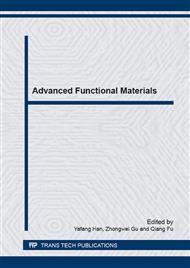[1]
A. Ballantyne, Modeling of the interaction of 10. 6um laser radiation with reinforced plastics[J] AIAA Journal, 1981, 19: 731.
Google Scholar
[2]
M. V. Allmen, Laser-beam interactions with materials: physical principles and applications [J]. New York: Springer-Verlag Publishing House, (1987).
Google Scholar
[3]
Q. C. Yu, H. Wan, Ablation capability of flake graphite reinforced Barium-phenolic resin composite long pulse laser irradiation[J]. Journal of Inorganic Materials, 2012, 27(2): 157-161.
DOI: 10.3724/sp.j.1077.2012.00157
Google Scholar
[4]
Milling, Laser defense and countermeasure system for aircraft [P]. U.S. Pat, 1976, 690: 3986.
Google Scholar
[5]
A. Ramalho, J. P. Celis, High temperature fretting behaviour of plasma vapour deposition TiN coatings[J]. Surface & Coatings Technology, 2002, 155: 169-175.
DOI: 10.1016/s0257-8972(02)00045-2
Google Scholar
[6]
X. Wang, H. Shun, et al, The performances of TiB2-contained iron-based coatings at high temperature[J]. Surface & Coatings Technology, 2006, 201: 2500-2504.
DOI: 10.1016/j.surfcoat.2006.04.025
Google Scholar
[7]
S. Romankov, W. Sha, et al, Fabrication of Ti-Al coatings by mechanical alloying method[J]. Surface & Coating Technology, 2006, 201: 3235-45.
DOI: 10.1016/j.surfcoat.2006.06.044
Google Scholar
[8]
J. Xiao, J. Chen, H. Zhou, Study of several organic resin coatings as anti-ablation coatings for supersonic craft control actuator[J]. Mater. Sci. & Eng: A, 2007, 452-453: 23-30.
DOI: 10.1016/j.msea.2006.10.020
Google Scholar
[9]
T. Zheng, J. Zou, B. Yu, Study on low density and heat resistant ablative coating[J]. Chinese Journal of Aeronautics, 2005, 18(4): 372-377.
DOI: 10.1016/s1000-9361(11)60258-6
Google Scholar
[10]
J. Li, Z. W. Guan, et al, Laser ablation resistance behavior of organosilicone composite coating on various substrates[J]. Material Science Forum, 2014, 789: 461-465.
DOI: 10.4028/www.scientific.net/msf.789.461
Google Scholar
[11]
C. C. Asmail, C. L. Cromer, et al, Instrumentation at the National Institute of Standards and Technology for bidirectional reflectance distribution function (BRDF) measurements[P]. Proc. SPIE 1994, 2260: 52.
DOI: 10.1117/12.189203
Google Scholar
[12]
F. E. Nicodemus, Geometric consideration and nomenclature for reflectance[R]. NBS MN-160, (1977).
Google Scholar


